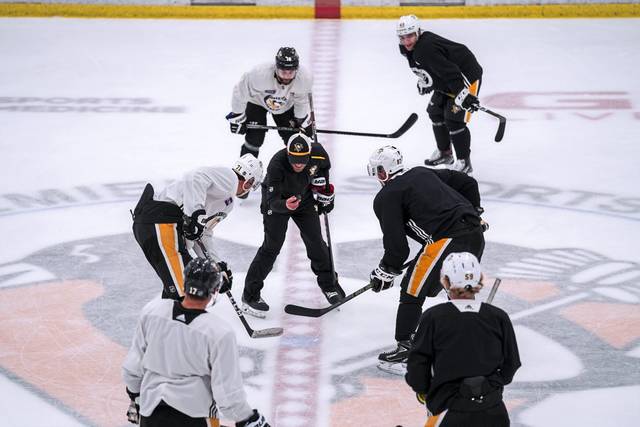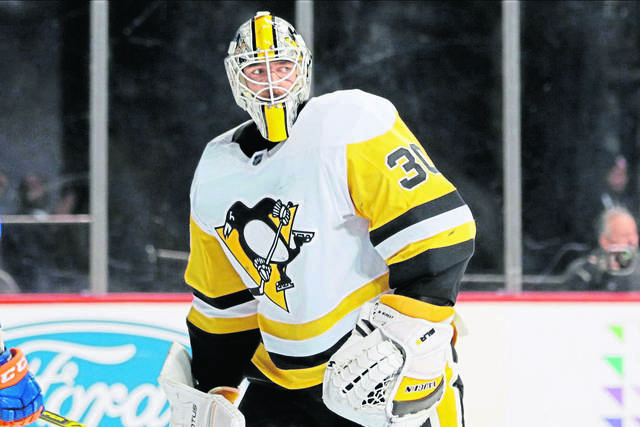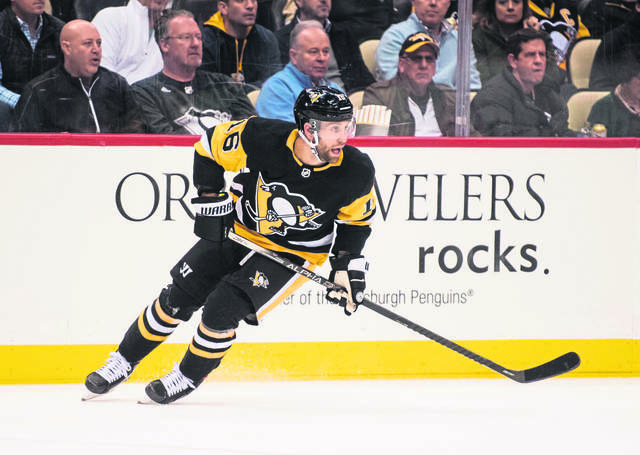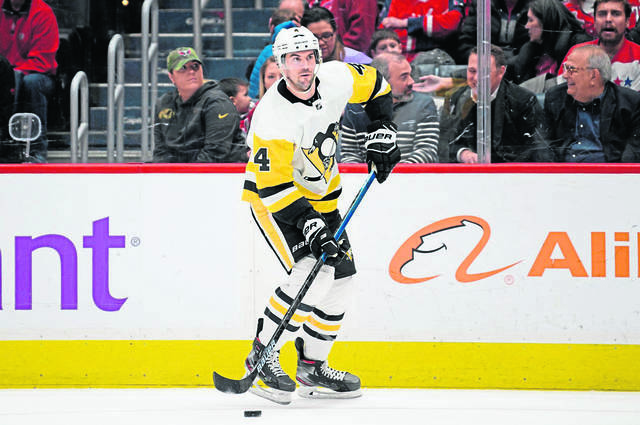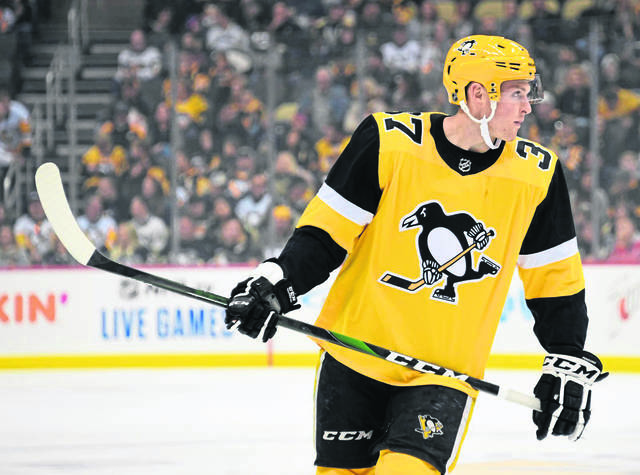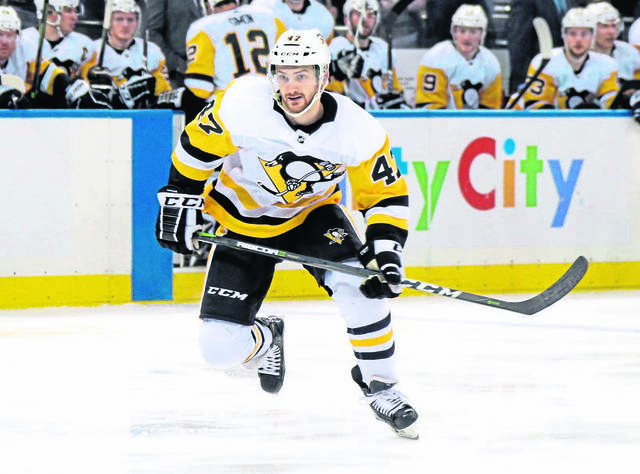5 things to track during a Penguins training camp unlike any other
When the Penguins convene for training camp Monday in Cranberry, things will look different from when they opened their previous camp in September.
After all, Alex Galchenyuk won’t be skating on Evgeni Malkin’s line.
That’s to say, this training camp won’t be trying to tinker with potential line combinations or assimilate new acquisitions into their lineup the way they would under normal circumstances.
All of that work was largely completed back in March by the time the NHL halted play because of the ongoing coronavirus pandemic.
This training camp primarily will be devoted to reintroducing hockey players to their vocation after four months of mostly being away from the rink.
“It’s going to be different for everybody,” Penguins general manager Jim Rutherford said in a conference call with reporters Saturday. “Having the camp at this point in time of the year, in the middle of the summer, after guys have had some time off … it will be interesting to see how certain guys have prepared.”
The Penguins appear to be prepared from the sense that there are few questions about their lineup entering this camp. They’ve researched and developed seemingly every conceivable line combination or defensive pairing through the proving ground of the 69 games they played during the regular season. The number of injuries and other various absences they endured from October through March more or less forced them to be creative in jury-rigging various combinations.
In other words, coaches won’t need to see if a line of Zach Aston-Reese, Teddy Blueger and Brandon Tanev might work over the next two weeks. They had six months of clinical trials to observe its efficacy.
Still, even though their lineup is largely determined, there are a handful of curiosities to observe in this unique training camp.
1. Who’s in net?
Truth be told, this was probably determined in the weeks before the NHL went into stasis, if not earlier.
Given his ample resume of postseason success, Matt Murray likely will be in net for the Penguins’ first game of the qualifying round against the Montreal Canadiens on Aug. 1 in Toronto. Things were pointing that way with how he and platoon partner Tristan Jarry were splitting their workloads in late February and early March.
Does Murray need to earn the No. 1 job in this camp? Probably not. But he probably could stand to verify the faith management has in him. Plus, unlike the previous two postseasons, journeyman Casey DeSmith won’t be the backup. Should something go catawampus for Murray, there’s a much stronger option coaches could turn to in the All-Star Jarry.
2. Lots of left wing options
The Penguins acquired Jason Zucker primarily because Jake Guentzel was injured. Now, Guentzel, who has been participating in the Penguins’ optional skates, is, by all accounts, recovered from the serious right shoulder injury he suffered in December.
Provided Guentzel is fully healthy, where does he play? His cohesion with Sidney Crosby is well documented. And when Crosby was sidelined throughout November and December, Guentzel displayed quite a bit of chemistry with Malkin as well.
Zucker, on the other hand, has played with Crosby almost exclusively, and to ample success, in his brief time with the Penguins. Presumably, he could do the same with Malkin but they shared very little common five-on-five ice time upon Zucker’s arrival.
3. Sorting out the power play
It’s a safe bet to assume Crosby and Malkin will be on the top power-play unit once the Penguins resume practicing it. Who joins them is anyone’s guess.
First, the net-front role. Patric Hornqvist’s acumen in that area is the primary reason he is an NHLer. But during the relatively few occasions the Penguins had everyone healthy, Guentzel seemed to be the coaches’ preference for that role.
Hornqvist executes that role more through chaos while Guentzel is a bit more calculated. And while there are few reasons to question Guentzel’s abilities, given how his injury occurred during a net-front scramble, will he have to fight through any self-confience issues to reclaim real estate near the blue paint?
The point on the top power-play unit essentially was manned by whomever was healthy enough to perform the task. By the time the regular season came to a halt, Justin Schultz was working this role, and Kris Letang was relegated to the second unit.
Schultz is probably closer to a true power-play quarterback than Letang, but Letang clearly has the advantage with regards to pure physical skills for the role.
Galchenyuk, since departed, and Letang manned the left side of the top power play to varying degrees of success, and Zucker inherited the role before the end of the regular season.
4. Depth up front
The long-term absences of forwards Nick Bjugstad (back) and Dominik Simon (shoulder) should not be dismissed. The Penguins are a lot less deep without their services.
It will prompt the likes of rookies Anthony Angello and Sam Lafferty to compete for the 13th, 14th and 15th forward roles with veteran Evan Rodrigues, who can play all three forward positions.
The versatile Rodrigues was acquired at the trade deadline and in only handful of games, he was used in a variety of roles due to the team’s various injuries up front.
Lafferty showed he can skate at the NHL level, but his play tailed off after a strong start. And Angello was largely sheltered during his handful of NHL games this season.
After that, the options drop off considerably with Adam Johnson and Phil Varone as the only other forwards on their training camp roster who have NHL experience.
5. Expanded rosters
Teams will be permitted to have a roster of 30 skaters and unlimited goaltenders for their travel parties to their respective cities.
On the surface, these extra bodies might appear to serve as little more than “Black Aces,” the players typically recalled under normal postseason circumstances to get more exposure to life as an NHLer.
But for coach Mike Sullivan, and probably most of his peers, the players selected for these assignments will have an important task over the next two weeks.
“We’ve got to have a training camp where I think it’s important that we have the ability to have intrasquad games,” Sullivan said by phone last month. “One of the things the coaching staff has talked about is getting our guys acclimated with a game environment. Intrasquad games are going to be important. We have to have sufficient guys in order to do that. The other aspect of it is, just like when you’re going into a playoff-type experience, you have to have enough guys as part of your group that in the event that injuries take place, you can continue to (dress) a competitive roster.”
The likes of Johnson, Varone or even forward prospect Sam Poulin might not play a game of consequence for the Penguins in August or beyond, but they’ll be expected to get their teammates ready for those contests.
Seth Rorabaugh is a TribLive reporter covering the Pittsburgh Penguins. A North Huntingdon native, he joined the Trib in 2019 and has covered the Penguins since 2007. He can be reached at srorabaugh@triblive.com.
Remove the ads from your TribLIVE reading experience but still support the journalists who create the content with TribLIVE Ad-Free.

